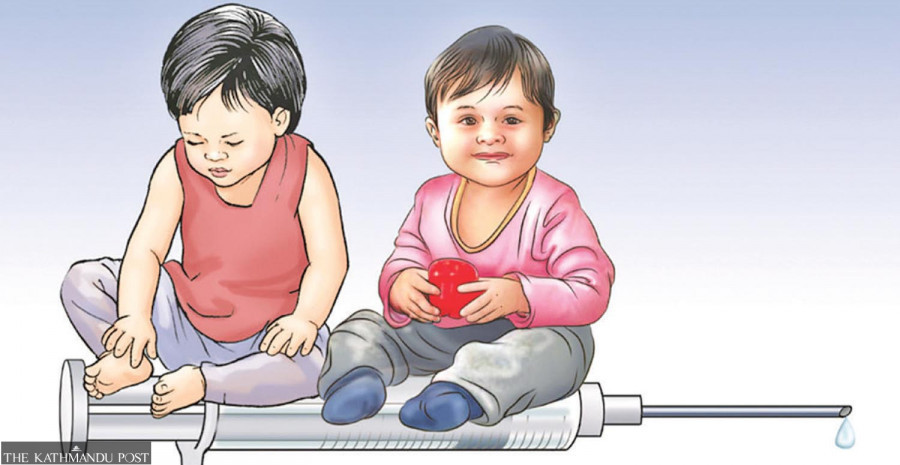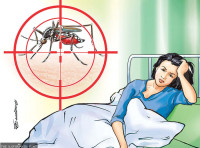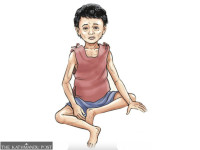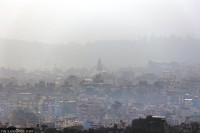Health
Cases of seasonal flu, pneumonia flare up in children
This week’s data shows a 15 percent respiratory syncytial virus (RSV) positive rate among children.
Post Report
Narayan Prasad Rimal, chief of Tarakeshwar Rural Municipality’s ward 6 in Nuwakot district, succumbed to pneumonia on Monday morning. Rimal, who was suffering from fever and pneumonia, was admitted to Bir Hospital when his health condition started deteriorating.
“We anticipate an actual surge in cases of viral infection after September, but people in our country get infected from viral diseases throughout the year,” said Dr Ashes Dhungana, a pulmonologist and a critical care physician at Bir Hospital. “Those having underlying health conditions and already suffering from chronic obstructive pulmonary disease and asthma must take extra precautions to stay safe.”
People in Nepal suffer from flu and pneumonia throughout the year, but at the time of change in season, the number of infections of respiratory and other viral diseases flare up alarmingly.
Data of regular surveillance carried out by the National Public Health Laboratory since the start of 2025 shows upto 40 percent influenza positivity rate during the season change. Infection with influenza viruses has declined in the adult population at present, but the laboratory’s cumulative data shows a 17.1 percent influenza positivity rate.
“This week’s data shows a 15 percent respiratory syncytial virus positive rate among children,” said Dr Ranjan Raj Bhatta, director at the laboratory. “Viral infection among children has started to surge over the last two weeks.”
Doctors attending patients at hospitals say that people are getting infected with multiple respiratory viruses—influenza A(H1N1), A(H3), influenza B, rhinovirus, and adenovirus—which are currently active.
They say that in most cases of viral infection, the disease gets cured after three days, but the problem is that the dengue virus is also spreading in communities, which poses a risk of misdiagnosis.
“Along with respiratory viruses, one could also get infected with the dengue virus in this season, and symptoms of the dengue virus and influenza virus are similar,” said Dr Ganesh Rai, a child health expert, who is also the former director of the Kanti Children’s Hospital. “If children have trouble breathing, have a high fever and have stopped eating or have seizures, they should be immediately rushed to the hospital.”
Otherwise, according to child health experts, parents can wait 48 to 72 hours and give normal paracetamol to the children if they have a high fever. They also suggest not giving methanoic acid and ibuprofen mixed drugs, which could exacerbate the ailments, if patients are infected with the dengue virus.
“Give the patients enough fluids—water and soup—and ask them to rest,” said Rai. “In most cases, the fever starts to lessen in two to three days; give paracetamol only if the fever is high.”
People first buy over-the-counter medicines such as paracetamol, cough syrup, and others and wait for several days, hoping the ailment will be cured at home. Only then do they take the patients to the hospital.
Doctors say one should not wait at home for the ailments to be cured if the patients have heavy breathing, wheezing while breathing, a high fever, or have stopped sucking breast milk or eating other things.
“Children could suffer from pneumonia, which can be severe,” said Dr Srijana Shrestha, a child health expert. “We would like to ask parents to avoid crowds, maintain hand hygiene and follow public health measures.”
The seasonal influenza virus causes respiratory complications, affecting the lungs. It spreads quickly in communities and can cause fever, cough, body aches, occasional vomiting, diarrhoea, and pneumonia.
Pneumonia, an infection of lungs caused by various types of bacteria, viruses and fungi, is the number one killer of children under five in Nepal. It kills more children annually than malaria, tuberculosis and HIV combined.
Fifteen percent of the total under-five mortality is caused by pneumonia, according to the World Health Organisation.
Doctors say pneumonia caused by bacteria is deadlier than that caused by viruses, and children under five and people above 65 years of age are highly vulnerable to the disease.
Thousands of people throughout the country get infected from pneumonia every year. And the average cost of families for a case of hospitalisation is Rs13,250, nearly half the average Nepali household's monthly expenses, a study carried out by Pneumo Nepal shows.
The study—which was carried out at Patan Hospital, Kanti Children's Hospital, Mission Hospital in Palpa, Bheri Hospital in Nepalgunj and BP Koirala Institute of Health Sciences—shows that the unexpected costs frequently push families into poverty.
“Two out of five of the poorest households experienced catastrophic expenses as a direct result of a child's pneumonia hospitalisation,” the report said.
Doctors say seasonal flu is also a respiratory virus that keeps mutating like coronavirus. The virus spreads in the same way, doctors say. However, people do not take the issues seriously, which is problematic.




 13.12°C Kathmandu
13.12°C Kathmandu













